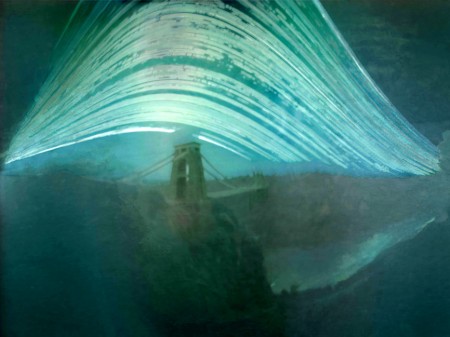
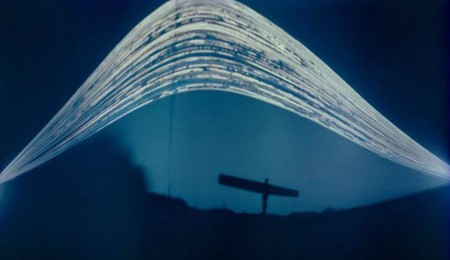
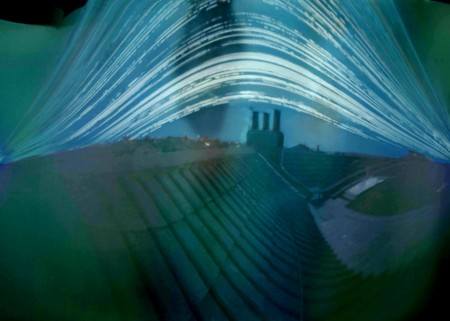
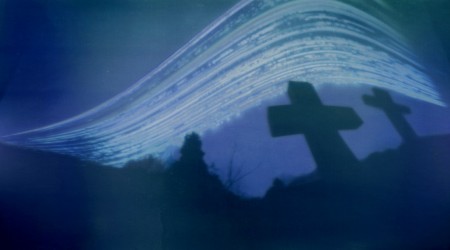
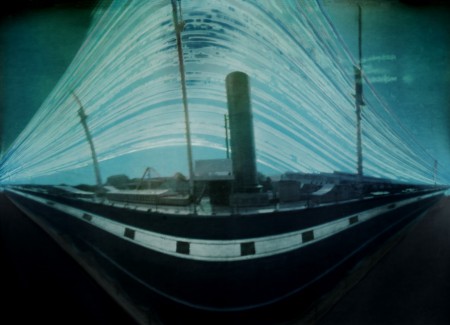
Photographer Justin Quinnell created these eerily beautiful photos with a pinhole camera fashioned from a soda can. Each image represents a six month exposure. Incredible. For the top one, Justin affixed the camera to a telephone pole where it sat quietly soaking in the view for half a year. The arc created by the sun is amazing, the time lapse gives us such a clear perspective on nature’s orderly design. Check out some more pinhole shots here.
On a side note, these images instantly reminded me of the Niépce Photograph (first ever photograph) which in turn got me thinking about the first photograph of a person (lower left, getting a shoe shine) and the Gorskii stuff (very early color photographer). It’s all so intriguing, like you’re seeing something you’re not supposed to.
Source Householdname Via Deru



Those are super badass. I wonder how big the actual hole was on the soda can? I’d love the have a print of the second one. So eerily calming.
Funny that you mention old photography. I just wrote a blog about the Hearst Castle in San Simeon and edited the photos in a way (at least that I thought) that were styled after old bw photos of the 30’s.
I love looking at old photos of people. They’re so interesting in the sense that the people you’re looking at are dead but yet, are present. Now back to watching the Twilight Zone…
6 month exposure?! I wonder indeed how big the actual hole was, it must have been miniscule. That and using ISO 1 film or something like that 🙂
The effect is quite stunning.
Realy amzing, I’m just wondering what the ISO values might be. Would be interesting to know more about the processes he used to acomplish this.
Those are beautiful. It’s awesome to see how far we can stretch something like photography that’s considered to be so “factual”.
Incredible!
These very much make me want to get up and make a pinhole camera, although apparently he’ll give you one if you kick in some money on an order so there’s that too. Cool to see that first photo of a person, I love the fact that it was incidental that the guy’s image showed up.
Scott, thank you for running one of my favourite blogs! I find your blog consistently interesting. The photos from Japan make me want to visit there, the music inspires me, and photos like these are just amazing.
Thank you, thank you, thank you – long may you run!
I had assumed this guy used some film camera with water housing and all that jazz, but a soda can?! Awesome, just awesome. I’d be curious to know what film he shot on.
I would have loved to see the look on his face the first time he developed one of those.
I’ve seen a book in which custom cameras were built exposures chronicling entire years, but I forget the title and author.
Anyway, these are much more aesthetically appealing than others like these that I have seen. Thanks for sharing!
This is called “Solarigrafía” (it´s a spanish word, something like solarigraphic or so) it was first used by Diego López Calvin many years ago. He run a blog: http://web.mac.com/diegolopezcalvin/solarigrafia/Bienvenida.html where you can see the whole project and the precise instruction for make the camera, I recommend you to visit it, is an open project and people submit their own Solarigrafías, you can use google translator.
The main point of Solarigrafía is that you don’t need to develop the sensitive paper you put inside the can, it become a positive itself because the sun action. Therefore you cannot take copies of your original image, making it a more unique process (images need to be scanned in order to be viewed, you’ll find more about the process in Diego’s blog)
I did a poster (http://www.flickr.com/photos/ruben_santiago/4821744484/) for a conference two month ago about photography where this technique was featured 🙂
Top and bottom photos are 10 minutes away from my house, stoked!
Been a fan of his for a long time – he has a short interview on lomography.com where he says his dad died during the first set of images and can pinpoint when/where he died in some of the photos – http://www.lomography.com/magazine/lifestyle/2010/06/16/passionate-pinholes-with-justin-quinnell
Hi Scott et al.,
These are awesome, however, when I found the series by Michael Wesely, I found these topped even the Quinnell series at some aspects, one them being concept, and the other the even longer exposure: http://itchyi.squarespace.com/thelatest/2010/7/20/the-longest-photographic-exposures-in-history.html
And well.. they just look incredible.
I just discovered something which is actually quite cool:
http://www.flickr.com/photos/shanghaisound/3324017761/in/photostream/
Coming from:
http://kateoplis.tumblr.com/post/1059566381/shanghaisoundbites
very nice use of long exposures as well…
project solaris.
Yep, there’s a site call Solargraphy (http://www.solargraphy.com/) that’s been doing this for years. They will send you a camera made from a 35mm film canister (ironic AND utilitarian). You ship it back to Finland and they’ll develop the film and put it on their site.
Solarigrafia was the name given by the creators of “Solaris Project” (Slavo Decyck, Pawel Kula and Diego Lopez Calvin) to the technique used to show how different are the paths of the sun in several latitudes on The Earth.
They launch Solaris project in 1999 and it was visible on the web till 2001. Nowadays you can visit a resume in:
http://free.art.pl/solaris/solaris/Solaris.html
After this, there were some workshops in Skoki, Poland were Tarja Trygg learnt from Slavo Decyk and Pawel Kula and launch from Helsinki University in Finland the global map of solargraphy.
You can find some news about a 3 years exposure in
http://web.mac.com/diegolopezcalvin/solarigrafia/Blog/Entradas/2010/12/1_Camera_133._Mexico_D.F..html